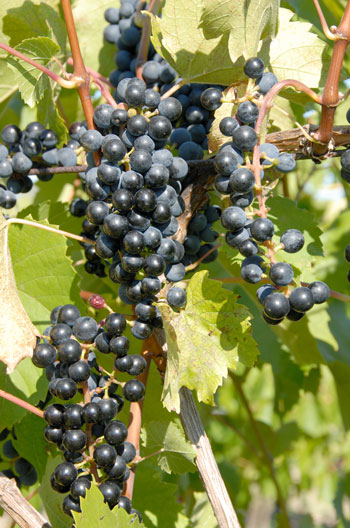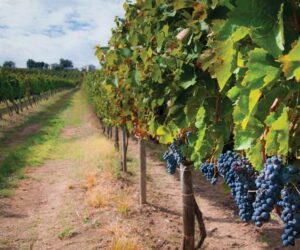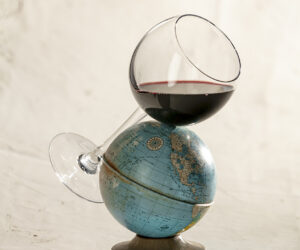Adversity leads to adaptation. As was told to me around a campfire circle some years ago at Nevada’s Great Basin National Park by a very animated Park Ranger as he was discussing how the bristlecone pines in the area had adapted to the harsh climates of the highest mountains in the western United States. Grapevines of the genus Vitis have probably been around for just as long as the bristlecone pine and the sheer number of species have shown their resilience over the millennia. They seem to have adapted to the many different climates and micro-climates on the planet, but then every once in a while, extreme weather or disease events decimate their numbers and the survivors are left to rebuild their population with a gene pool stronger than the previous generation. It is these genetic characters that are the tool chest for modern day grape breeders, seeking to build a better vine, and better yet, a vine that produces the best quality fruit that can be made into wine. The scourge of the late 1800s was phylloxera, black rot, powdery mildew, and downy mildew. Baco Noir emerged with the ability to be disease resistant and the wines became popular. But when France did not sanction hybrid grape varieties under the Appellation d’Origine Contrôlée (AOC), its planting decreased considerably. Despite its decreasing popularity in France, it has found a new niche on this side of the Atlantic in soils and climates that it grows well in.
Origins of Baco Noir
François Baco was a gifted French grape breeder in the late 1800s. Monsieur Baco (M. Baco hereafter to not confuse with the variety name) understood the diseases of the day and was looking to make a variety that was resistant to the whole gamut of vineyard maladies, all the while keeping in mind, someone had to make wine from his progeny . . . a challenge I know all too well from my days at UC-Davis. M. Baco chose to cross Folle Blanche with Vitis riparia Grande Glabre to make his Baco Noir grape. Two very interesting choices at that. The first is that Folle Blanche, then known in southwestern France as Piquepoul du Gers, is an old endemic vinifera grape, with its main use in the production of Armagnac and Cognac. Evidence suggests that it originated in the Landes region where M. Baco did his work.
M. Baco chose to cross Folle Blanche with Vitis riparia Grande Glabre
to make his Baco Noir grape.
Considering M. Baco’s quest to breed grapes with some disease resistance, it is interesting that he considered Folle Blanche in that it is susceptible to bunch rot, black rot, mites, and to a lesser extent downy and powdery mildew. The second was his choice of using V. riparia Grande Glabre, a North American native grape variety. As was the norm of the day to breed with native American grapes to promote phylloxera resistance, it turns out V. riparia Grande Glabre has female-only flowers and sterile pollen, so there must have been a third player in the mix. It is suggested that M. Baco used a mix of V. riparia pollens to make his Baco Noir. Incidentally, Baco Noir is not a mutation of Baco Blanc, the latter being a cross of Folle Blanche and Noah, it’s more a half sibling of Baco Blanc (which is a notable varietal in itself since it is the only hybrid grape approved under France’s AOC standards). Noah is a now almost extinct American hybrid.
Baco Noir in the Vineyard
Viticulturally, what M. Baco came up with was an early budding grape, making it susceptible to spring frosts. On the positive side, Baco ripens early and has good resistance to downy and powdery mildews. Its small- to medium-sized bunches are high in acid and low in tannin. Where M. Baco scored was that for being a fifty percent vinifera hybrid, Baco did not come with the foxy characters that many other hybrids express.
Once widely planted in France, notably Burgundy, Anjou, and its home region of Landes, when it was not included in the French register of authorized varieties, its area diminished to just 28 acres, reported in 2008 by Jancis Robinson. But this French-American hybrid made the trip across the Atlantic and was introduced into parts of North America in the 1950s. Upstate New York, Michigan, Oregon, Colorado, and Ontario, Canada are places where it is most popular. Baco Noir is well suited for cooler climates where traditional vinifera varieties cannot or will not grow well and in these areas, and as with most hybrids, they have a devoted following.

Of course, wine begins in the vineyard, and Baco Noir is known for its high yields. One picture from a French website detailing M. Baco’s work depicted a vine so overloaded with grape clusters barely a leaf could be seen. Overall wine quality is affected by over-cropping and in the areas where Baco Noir is grown, getting fully ripened grapes before the cool weather arrives is part of the challenge. Fortunately its early ripening is an asset. Most importantly vine balance is the key to get to the finish line, that is harvest, on time.
Baco Noir in the Winery
The wines of Baco Noir are crisp in acidity, and sometimes compared to the composition and quality of the Beaujolais Cru, those made from Gamay Noir. The acidity takes time to mellow. Encouraging the malolactic fermentation will help this. The wines are very dark in color, yet low in overall tannin content. While not really considered an age-worthy wine, they do need time in the cellar to soften the acidity and boost the mouthfeel and texture. Aging in French or American oak barrels helps encourage this. I find that French oak fits my flavor preference over American oak with this type of wine, but my pocketbook smarts as a result. In my opinion, French oak adds more mouthfeel, which is very important and a good tool in balancing acidity. As a winemaker who traditionally makes wines that are higher in acid, many of my blending activities focus more on how the wine feels in the mouth as opposed to what the raw numbers are telling me. I have tasted many examples of Baco Noir over the years and feel that blending with Baco is a direction that should be considered. Its high acid, deep colors, and low tannins can be used to build on another wine’s deficiencies. Exploring the synergies of blending is useful, and downright fun at that!
Overall wine quality is affected by over-cropping and in the areas
where Baco Noir is grown, getting fully ripened grapes before the cool
weather arrives is part of the challenge.
Some winemakers report that they prefer a carbonic maceration, or partial carbonic (half must/half berry) to enhance the fruitiness and retain the color. These styles are best consumed when young, but that is up to the winemaker to read the wine and find out what direction it wants to go. There are some reports of aging Baco Noir wines that continued to develop up to ten years, but the right growing conditions are needed and a deft hand is required in the winery.
Baco Noir in the Kitchen
Baco Noir and food pairings is also something to be considered. Wines higher in acid pair well with many foods, and tomato-based pasta dishes come to mind. Chicken and pork with light sauces would also be of interest in the kitchen when pairing with the wine. This is another fun aspect of any variety, play around with it, and while not only pairing it with food, use it in the food such as preparing sauces as well. Try reducing it into a red wine sauce to serve over pork. But remember, only the best wines should be used in reduction sauces. The common mistake is that if a wine tastes bad, you just use it for cooking. Why is that a mistake? You are just taking all those bad things you don’t like about a wine and concentrating them, so chef’s need to beware!
As we circle back around to adversity leading to adaptation, we reflect on what M. Baco came across. That adaptation he made in his laboratory and nursery actually led to a very diverse variety, with respect to site choice and wine style, that found a home on this side of the Atlantic. It is not that Baco Noir alone was “expelled” from France, it is that most all of the hybrids in France were not included in the appellation system that was created. Once phylloxera-resistant rootstocks were developed and grafting techniques were perfected, these hybrids were able to find a new home across an ocean. This is the current day challenge of grape breeders worldwide. Grape breeders are what I consider the “planners of the future,” making educated guesses on what the future holds for viticulture. You win some, you lose some. France lost one, and North America adapted in the case of Baco Noir.
Baco Noir (Partial Carbonic Style) Yield 5 gallons (19 L)
Ingredients
125 pounds (57 kg) fresh Baco Noir fruit (juice or must can also be purchased in regions Baco is grown)
Distilled water
10% potassium metabisulfite (KMBS) solution. (Weigh 10 grams of KMBS, dissolve into about 50 mL of distilled water. When completely dissolved, make up to 100 mL total with distilled water.)
5 g Lallemand BGY yeast (UCD-51 from Lallemand or Red Star Premier Cuvee can be used as a substitute.)
10 g Di-ammonium phosphate (DAP)
10 g Go-Ferm
10 g Fermaid K (or equivalent yeast nutrient)
Malolactic fermentation starter culture (CHR Hansen or Equivalent)
Other equipment or needs specific to this recipe
15-gallon (57-L) food-grade plastic bucket for fermentation.
5-gallon (19-L) carboy
1–2 one-gallon (3.8-L) jugs
Racking hoses
Crush equipment, destemmer/crusher
Wine press
Inert gas (nitrogen, argon, or carbon dioxide
Ability to maintain a fermentation temperature of 85–90 °F (30–32 °C)
Thermometer capable of measuring between 40–110 °F (4–43 °C) in one degree increments.
Pipettes with the ability to add in increments of 1 mL
Step by step
- Clean and sanitize all your winemaking tools, supplies, and equipment before any process
- Crush and destem half of the grapes. Transfer the must or juice to your fermenter.
- During the transfer, add 7 milliliters of 10% KMBS solution (this addition is the equivalent of 50 ppm SO2). Mix well.
- Add the remaining whole clusters to the must.
- Layer the headspace with inert gas and keep covered. Keep in a cool place overnight.
- The next day suspend the Fermaid K in a little distilled water (usually ~20 mL). Add to must or juice and mix well.
- Prepare yeast — heat about 50 mL distilled water to 108 °F (42 °C). Mix the Go-Ferm into the water to make a suspension. Pitch the yeast when the suspension is 104 °F (40 °C). Sprinkle the yeast on the surface and gently mix so that no clumps exist. Let sit for 15 minutes (do not exceed 20 minutes). Measure the temperature of the yeast suspension and the must. You do not want to add the yeast to your cool juice if the temperature of the yeast and the must temperature difference exceeds 15 °F (8 °C). Acclimate your yeast by taking about 10 mL of the must juice and adding it to the yeast suspension. Wait 15 minutes and measure the temperature again. Do this until you are within the specified temperature range.
- When the yeast is ready, add it to the fermenter and mix.
- You should see signs of fermentation within about 1–2 days. This will appear as some foaming on the must surface and it will appear that the berries are rising out of the medium. This is referred to as the “cap rise.”
- You need to have on hand the ability to push the grapes back into the juice to promote color and tannin extraction. This is called “punching down” and this should be done two to three times per day. Use a clean and sanitized utensil or your hand to mix.
- Monitor the Brix and temperature twice daily during peak fermentation (10–21 °Brix). Morning and evening is best and more often if the temperature shows any indication of exceeding 85 °F (29 °C). If this temperature looks to be exceeded, cool the must by your usual cellar means.
- At about 19 °Brix, dissolve the DAP in a small amount of distilled water and mix into the must
- At about 10 °Brix, break out the destemmer/crusher and run the must through it to break up the whole clusters and remove the stems. Transfer the newly crushed must back to your fermenter.
- When the Brix reaches zero (about 5–7 days), transfer the must to your press, and press the cake dry. Keep the free run wine separate from the press portion for now.
- Transfer the wine to your carboys and jugs. Your press fraction may only be 1–2 gallons (3.8–7.6 L). Make sure you do not have any head space. Label the vessels.
- Inoculate with your malolactic (ML) bacteria. Check the manufacturer’s instruction on how to prepare and inoculate. Place an airlock on top.
- Monitor the ML fermentation (MLF) using a thin layer chromatography assay available from most home winemaking supply stores. Follow the instructions included in the kit.
- At the completion of the MLF. Add 2 mL of fresh KMBS (10%) solution per gallon (3.8 L) of wine. This is the equivalent to ~40 ppm addition.
- Allow the wine time to settle in a cool place.
- After two weeks, test for pH and SO2, adjust the SO2 as necessary to attain 0.8 ppm molecular SO2. (There is a simple SO2 calculator at www.winemakermag.com/sulfitecalculator). Check the SO2 in another two week and adjust. Once the free SO2 is adjusted, maintain at this level. You should check every two months or so, and before racking.
- Rack the wine clean twice over 3–5 month’s time to clarify and add a little microoxygenation. Fining/filtration are generally not needed if SO2 levels are maintained and there are no surface films or indications of subsequent fermentations.
- Once the wine is cleared, it is time to move it to the bottle. This would be about twelve months after the completion of fermentation.
- Make the project fun by having a blending party to integrate the pressed fraction back into the free run. You may not need it all, use your judgment and make what you like.
- If all has gone well to this point, given the quantity made, it can probably be bottled without filtration. That said, maintain sanitary conditions while bottling. Once bottled, you’ll need to periodically check your work by opening a bottle to enjoy with friends. Have fun!







